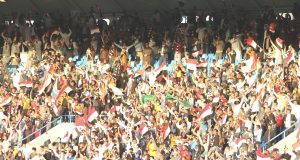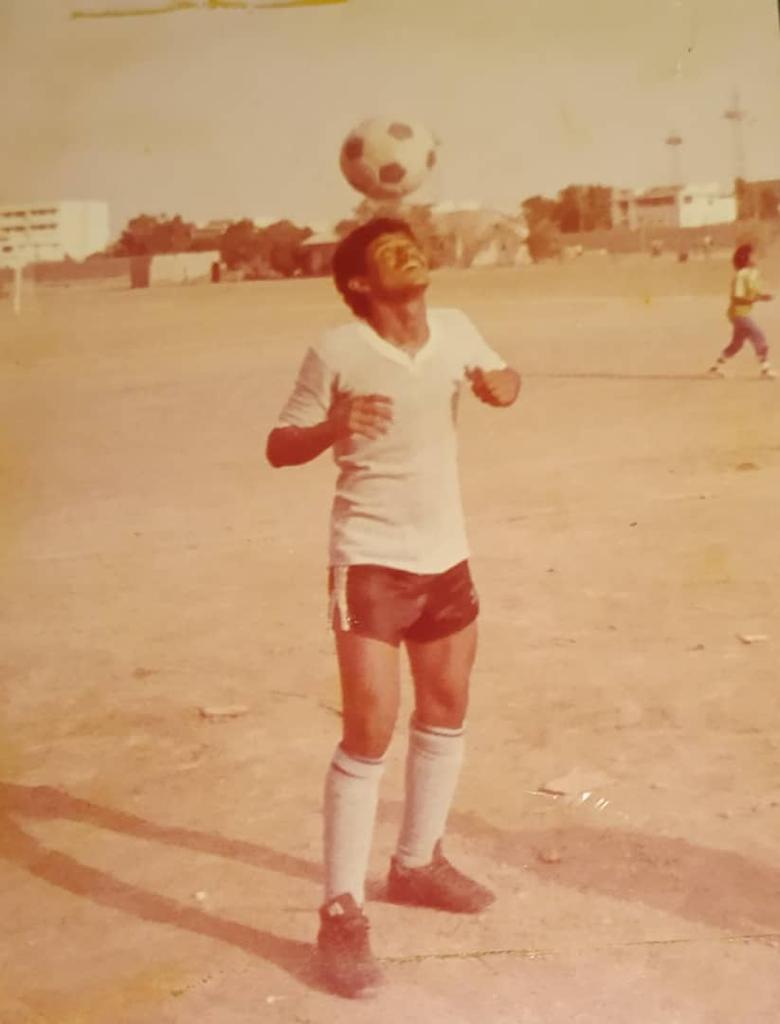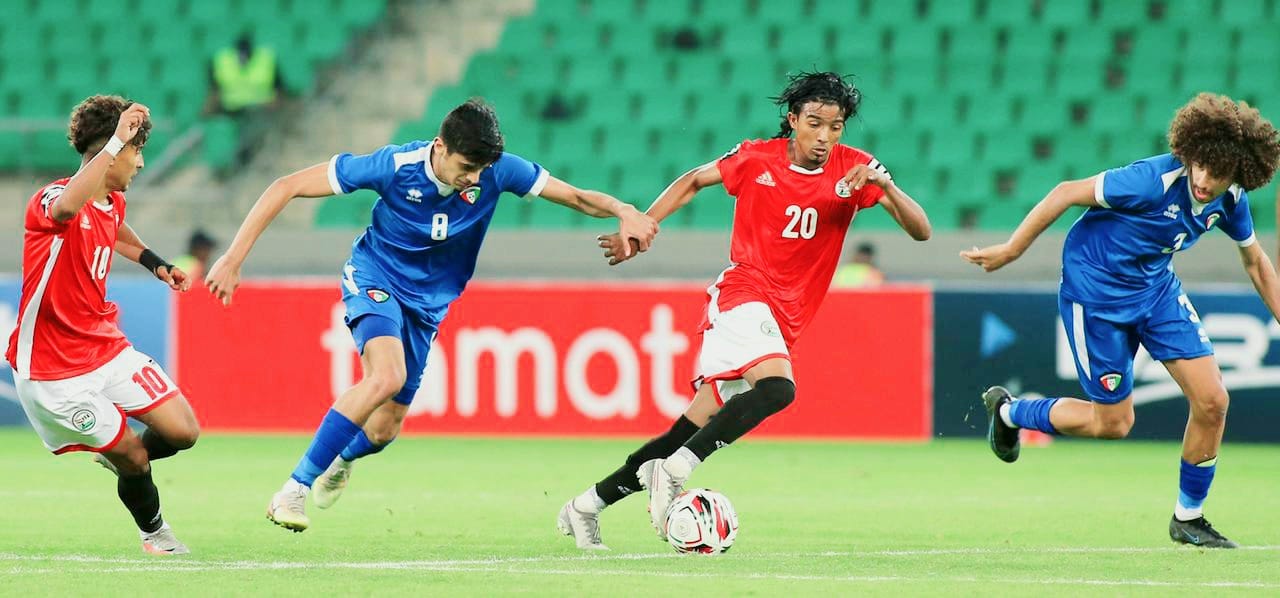The Perpetual Hope of Football in Yemen
Photo Essay

Across generations, football in Yemen has become rooted in popular culture. By examining the role football has played in creating cohesion across different segments of Yemeni society, Hala Alsadi argues that football has the potential to play a unifying role throughout Yemen.
Shibam, Yemen on February 21, 2011, a group of young boys enjoying a game of football. Source: Alamy
Across the world, it was the time again when all eyes were glued to screens. With the World Cup season, whether you are a fan of football or not, the crowds were sure to sweep you up with their national chants and high spirits. For Yemenis, this atmosphere brought back a moment from December 2021, when Yemen’s junior football team won the West Asian Junior Championship.

Across Yemen, streets could not contain the celebrations after the win. Fireworks lit up the skies. It was a remarkable moment of joy and solidarity among Yemenis inside the country, and scattered all around the world. People in Yemen had gathered in huge crowds on streets to watch the final game. Outside Yemen, we were exchanging pirated streaming links to catch the score as the minutes counted down.
Spirits during the championship were tense, yet high, as if Yemen was about to win the World Cup. This made the ecstasy of winning gain a different flavor, especially because it was also born out of struggle. For the first time since the war began, everyone around the country claimed victory, and the lines of division that have plagued Yemen seemed to temporarily fade amid the collective celebrations. The victory chants on the streets were equally loud online, with congratulatory photos and videos taking social media by storm.
Yemen’s junior team celebrate their win at the West Asia football tournament in December 2021. Source: Yemen Used to Be Archive
The junior team’s win was a high point for nationalist fervor across Yemen, especially after years of divisive conflict. It made clear that football can reinforce national pride and unity even during the most trying of times. The past decade in Yemen has left people across generations and different backgrounds feeling defeated. This is why the reaction to the win was extravagant: it emerged as a reassurance of hope.

To be a member of Yemen’s junior team meant that these footballers were between four and six years old when anti-government protestors took to the streets in 2011. This team represents Yemenis’ battles against adversities, as well as the possibility to dream. These themes are relevant to so many young Yemenis since the beginning of the war, who are hustling to make a living for themselves and their families.
Furthermore, sports culture is connected to the stories a society tells about itself. These stories inform national histories and collective memory. Many scholars have noted the connection between football and national identity, yet in the context of Yemen, this is a complex mission. In this moment of Yemen’s history, it is difficult to assume one unified understanding of Yemeni identity. There is ambiguity, especially for younger generations, and yet the momentum from this football win seemed to revive the popular and shared memory of Yemen that fuels collectiveness around the sport. Another way to say it: perhaps there is an unconscious unified national identity that people grasp through football.
More Than a Sport
Captain Ali al-Ashwal, captain of al-Wehda Club Sanaa and President of the Football Association, posing with Captain Muhammad al-Jahmi, captain of al-Jeel Sports and Cultural Club in Hodeidah, Yemen, 1970s. Source: Yemen Used to Be Archive
Football has a long history in Yemen, and its importance has remained despite several eras of major political change. Not long after declaring independence from the British, football became the most popular game in south Yemen. While in northern Yemen, the popularity of football spread more slowly in the late 1950s, limited by cultural and political factors. Studies conducted in 2000 and 2008 by Thomas B. Stevenson and Abdul-Karim Alaug, scholars who extensively studied football in Yemen, claim that in south Yemen between 1965 and 1967, football clubs were strongly nationalist. They were direct participants in the liberation movements against the British. Later, these clubs adopted socialist ideology.
Football as a tool for anti-imperialist fervor was a reversal from its initial position within society in south Yemen. Initially, football was a branch of the imperialist institution, according to Stevenson and Alaug. The British fostered sports clubs for their troops and limited participation to members of the south Yemeni elite.
In the early 1970s after both north and south Yemen gained independence and became republics, football became part of the national agenda of both states. National teams and local clubs carried a significant symbolic value, not only through participation in local championships but also through their participation in regional and international competitions. Football served to literally and symbolically promote the state, national consensus, and solidarity. Rural areas and villages were integrated into the state through their local football teams and seasonal leagues. These teams would travel to compete against each other at the national level, and in doing so, they mingled with teams from different areas. This also occurred at an international level. Participation in matches abroad, regardless of whether a team won or lost, became a diplomatic strategy to display the country’s power.
The Football Pitch in the Streets
In an improvised camp for internally displaced people near Abs in the northwestern province of Hajja, Yemen, a group of boys can be seen engaged in a lively game of football on a February day in 2019. Source: Alamy
The sense of camaraderie that is gained when a community gathers around a football match extends beyond the 90 minutes of the match itself. There is a ritualistic aspect to football, being a game of structure, repetition, tactic, and symbolism. The community built around football is born out of neighborhood alleyways and abandoned squares squatted in by young boys. These scenes exist in different locations across Yemen. The players structure themselves into teams and manage to find the tools to imitate a professional football match. Street matches often attract attention from passersby, who can join the game as players or cheering fans.
A sunny day in Mukalla, Yemen, and a group of people enjoy a football game on a sandy beach, 2020. Source: Alamy.
These casual teams sometimes blossom into more formal teams in villages or districts, which then compete in national-level events. Sports are an overlooked opportunity to foster community-building activities for young Yemeni boys and girls. Football is an engaging and contagious game; it brings the communities of players and their supporters together through healthy competition. The sport can dissolve social, religious, and cultural differences. Through this, it can contribute to peacebuilding and attempts at restructuring fractured communities. This has happened in various countries across the globe. For example, in Cameroon research concluded that football contributed to building a sense of a nation state and advanced social cohesion.
Furthermore, football has woven together different generations of Yemenis in a way that has fostered community-building. Footballers from the 1970s and 80s are now the coaches, trainers, administrators, and the biggest fans of the present players. Much of this work within football is self-sustained and collaborative. Qais Mohammed Saleh, the coach leading the national junior team, was a former footballer himself. Saleh played for two decades between 1992 and 2013 with al-Tilal club in Aden, the oldest club in the Arabian Peninsula. Additionally, the older generation still meets in Facebook groups to reminisce about what they describe as the “golden days” of Yemeni football.
The “Golden Days”
The opening league game between Alwahda and Gaish (military team) on September 27, 1987. In the front, we see Hala Alsadi’s father surrounded by his teammates, including Mohammed Alabadi on his left and Omar Al Barik behind him. The referee, Mohammed Alnoigi, was overseeing the match. Source: Hala Alsadi
Between 1980 and 1989, my father, Khaled Alsadi, played football professionally for the military football club in Aden. Unlike popular teams coming from cities or villages, military football clubs foster a far more disciplined environment for playing the game. In those days, many football games were held on sand fields before grass became more common. Still, football fervor was high, my father told me in a recent phone conversation about his time playing football professionally: “Matches were always full of fans, coming to cheer. They came from all over to watch the games and cheer for a roster of players who now make up the history of football in south Yemen.”

From a young age, he played in neighborhood streets, meeting new fellow players and travelling around south Yemen to play matches. After my father joined the military club, his team travelled to play competitive and friendly games across the Soviet Union, as well as in African nations like Somalia and Ethiopia.
My father said that he viewed football as the cornerstone of his community. “Most long-term friendships of more than 30 years are with people I met playing football. Football is a game of collectivism that brings humans together, some people took the game extremely seriously, but football at its core is about togetherness rather than divisiveness.”
A group photo of the Yemeni national football team, at the end of the 1960s. Source: Yemen Used to Be Archive
Meanwhile, the larger community in Aden found hope and thrills in looking forward to their team’s potential win: “To score and to win among the crowds is an indescribable feeling, and the match would become a hot topic among people. Football in my time was the most popular activity.”
Football also served as a way to bridge divides that plagued Adeni society during the 1980s. By then, south Yemen was a decade into independence, political reform, and the rise and fall of leadership parties. Although the political conflict was contextually different in that place and time, the national uncertainty and divisiveness share similarities to what is taking place in Yemen today.
There is plenty of space for community building and solidarity that exists organically in football. Thus, the sport is a potential forum to contest and build notions around national identity/ies in a country that in other arenas often struggles to do so. Then, as well, the love of football remains timeless across generations in Yemen.
One Trophy Today, and Ten Others Tomorrow
Hamza Mahrous, a young player of the Yemeni youth team. Source: Hamza Mahrous Facebook Page
One young Yemeni from the junior team is an example of how football can capture the attention of Yemenis across the country. Journalist Abdullah Ali followed the story of Hamza Mahrous, whose family was displaced from Hodeidah in 2017, after brutal fighting there forced his family to escape to Taiz. Yet for Hamza and his family, as is the case for many Yemenis, escaping violence does not necessarily mean finding safety, as Taiz city is severely devastated by war and deprived of basic services as well. Despite this adversity, Hamza continued to pursue his passion, football, in his new community. While playing on his school’s team, he was scouted to join the junior team in 2019. From there he joined the team of champs.

Football is full of stories of underdogs beating the odds and finding opportunities to thrive. These stories capture the imagination of viewers and instil hope even when life is full of setbacks. For Hamza, although his circumstances forced him to flee his home and work at a young age to support his family, he was still dreaming of the field. He joined Ahli Taiz club, which was the club he grew up admiring. For Hamza, playing a match is a way to express belonging to the entire nation of Yemen. “We play carrying the hopes of 30 million people” is a sentence he repeats in several interviews.
Perhaps the future national hero figure of Yemen will emerge from the same alleyways as my father or Hamza. History has seen football legends come from places ravaged by violence and atrocities. One example is a story that came from Naples, the southern Italian city. Suffering from high unemployment, organized crime, and systematic economic marginalization, Naples was one of the most disadvantaged cities in Italy, and negative stereotypes about life there abounded. The city was in need of a hero. Cue Diego Maradona, who brought a feeling of salvation to Naples. “Through football, Maradona gave them meaning, purpose, and pride”, wrote journalist John Vincent for the cultural magazine Italy Segreta. On a smaller scale, young Yemeni footballers brought this kind of hope and pride to people across Yemen again. Now, the hope is that football can continue to play this unifying role.
The photo essay was written by Hala Alsadi and developed by Ahmed Alhagri and Loay Amin.
Text was edited by Laura Kasinof, copy edited by Jatinder Padda, and translated into Arabic by Enas El-Torky.

